Abbreviation TCC Dates 11 Jul – 7 Aug 2017 | Formation 1967 Legal status Active, non-profit | |
Similar Toronto Jazz Festival, Beaches International Jazz Festi, Luminato Festival, North by Northeast, Canadian Music Week Profiles | ||
The Toronto Caribbean Carnival, formerly and still commonly called Caribana, is a festival of Caribbean culture and traditions held each summer in the city of Toronto, Ontario, Canada. It is a Caribbean Carnival event, that has been billed as North America's largest street festival, frequented by over 1.3 million visitors each year for the festival's final parade and an overall attendance of 2 million.
Contents

The festival was introduced to Canada by immigrants from Caribbean Islands. Much of the music associated with the event, such as steel pan, soca and calypso. Caribana reflects the Carnival events that take place in several Caribbean Islands, such as the Caribbean Islands Carnival. The entire event, which is one of the first Caribbean Carnivals along with those in New York City, Notting Hill and Boston to be held outside of the Caribbean region, brings in over one million people to Toronto and over $400 million into Ontario's economy, annually.
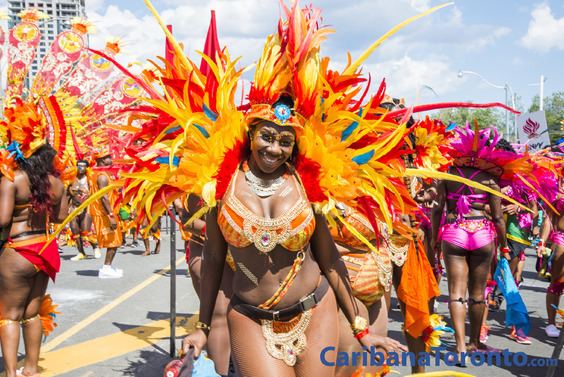
Following a trademark law dispute between the original operators of the festival, who still owned the Caribana name, and the current organizers, the festival was renamed Scotiabank Toronto Caribbean Carnival in May 2011. In 2016, the name was changed to "Toronto Caribbean Festival" after Scotiabank ended its sponsorship.

Events
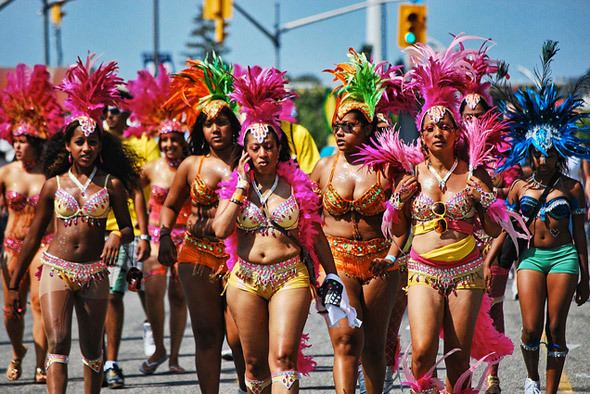
While the Caribbean Festival holds events over several weeks, the culmination of the Caribana event is the final weekend which is punctuated by the street Parade of Bands. This weekend traditionally coincides with the Ontario statutory holiday Civic Holiday. The street Parade of Bands consists of costumed dancers (called "Mas players") along with live Caribbean music being played from large speakers on the flat-bed of 18 wheeler trucks. The genre played is mainly soca calypso, and steelpan, but you can also find floats which play chutney and reggae.
J'ouvert
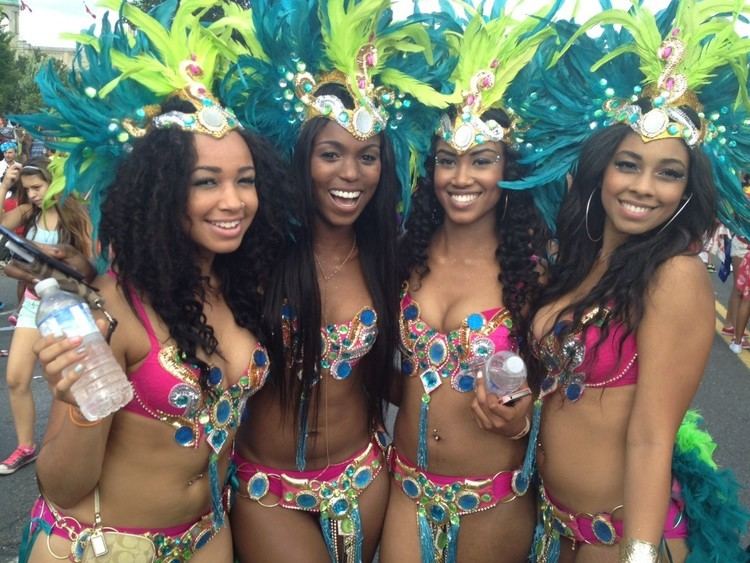
In addition to the main parade, the Caribbean community also celebrates a smaller pre-dawn parade known as J'ouvert (Pronounced "Jou-vay"). This too has been modelled after and taken from Trinidad Carnival. In Caribbean French-creole this means "day open" or morning. The J'ouvert portion of Carnival is the more rhythmic part of the Carnival celebration and is usually featured with steelpan bands, and persons using improvised musical instruments. It is not usually accompanied by any singing, but will have a lot of whistles and other music makers. Spectators and or persons "playing Mas" will occasionally get themselves covered from head-to-toe with mud, flour, baby powder, or different water-colored paints in the tradition of the Caribbean-based J'ouvert celebrations. In many instances everyone in the band is supposed to resemble evil spirits while parading around at night. There are some common characters that are a part of Afro-Caribbean folklore and include things like Red Devils (people covered in red paints), Blue Devils (people covered in blue paints), Green devils, Black devils, Yellow devils, White devils, (usually people throwing baby powder or flour.) or people just covered in other concoctions which are supposed to resemble mud or oil.
Fêtes
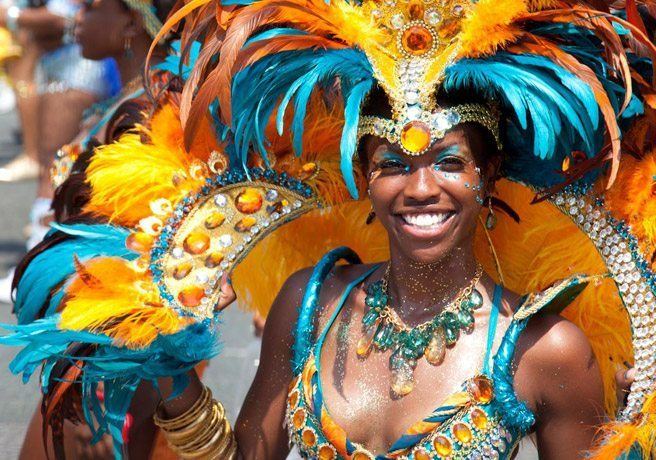
Leading up to the main parade a number of Caribbean music artists perform in Toronto. These parties are generally called "fêtes", for a French-Creole Caribbean word meaning "festival", and usually start in June–July.
Bands
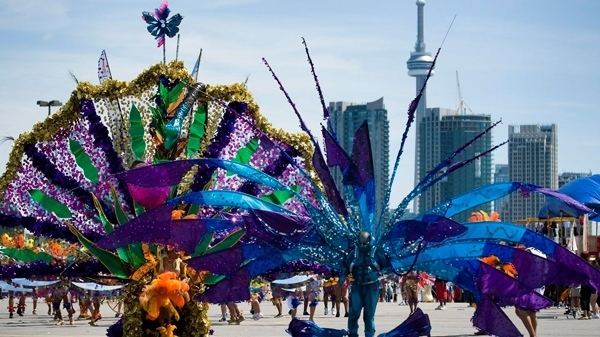
The bands are the most important part of the main Carnival parade. The bands are actually in competition with one another during the parade. They must pass a judging spot which will rate each band section for its costume design, energy of masqueraders, creativity of presentation and so on. Work on the costumes begin soon after the previous year's celebration and usually takes one full year to complete all of the costumes.
History

Caribana has been run annually since 1967, first performed as a gift from Canada's Caribbean community, as a tribute to Canada's Centennial. The main Caribana events were run by a nonprofit Toronto-based organization, the Caribbean Cultural Committee (CCC), its board members mostly made up of expatriate-Caribbean nationals living in Canada.
As the festival became a permanent annual event, the festival organization became dependent on borrowing money from the City of Toronto prior to the festival, to be repaid out of festival profits afterwards. By 1992, the festival had built up a significant debt to the City. To aid the festival, the City of Toronto forgave the outstanding debt after the 1992 event. The same year, Caribana developed a new partnership with Toronto-area hotels.
In 1993, the organization fired its operating chief. At launch in Nathan Phillips Square, Premier Bob Rae calls the event a "beacon of hope" for all Canadians, as a symbol of racial harmony. "Carry a Can to Caribana" launched, in support of Daily Bread Food Bank. Also in 1993, the Caribana Marketplace covered market was added at Marilyn Bell Park along the parade route. A well-behaved crowd and barricades along the entire parade route contributed to an incident-free parade. With attendance down, the board chair blamed the federal and provincial tourism ministries for not funding their American advertising campaign.
In September 2004, after the 37th festival, the consul general of Trinidad and Tobago pledged to work more closely with Caribbean Cultural Committee to get support for the carnival from the business community; the committee received around CA$1 million that year from the national, provincial, and city governments, but it cost about twice that run the festival.
In 2006, the Caribbean Cultural Committee ran into financial troubles again. Because of a lack of financial accountability, the City of Toronto cut off funding until the organization could get its finances in order. Instead, the funding was given to the Toronto Mas Band Association which had organized the festival in 2002. Due to an ongoing dispute about the ownership of the trademark "Caribana", the 2006 festival was promoted as "the Toronto Caribbean Carnival (Caribana)".
In May 2010, the festival added a new initiative to involve post-secondary schools. The only college to participate was Centennial College School of Hospitality, Tourism and Culture, where they created a costume theme of the Tropical Amazon. On September 1, 2010, new management took over the Festival Management Committee (FMC) and named Denise Herrera-Jackson as CEO/Chair of FMC and Chris Alexander as CAO.
A naming dispute arose over the use of "Caribana." The Caribbean Cultural Committee claimed that it legally held the trademark for "Caribana". In April 2010, a panel for the World Intellectual Property Organization (WIPO) ruled that Scotiabank, as the sponsors of the Caribana festival, did not have grounds for being awarded the domain name caribana.com from its current owners the Working Word Co-operative.
In 2011, the Ontario Superior Court Of Justice ruled that the Caribana Arts Group (CAG), the successors of Caribbean Cultural Committee (CCC), has legal rights to the name Caribana. On May 25, 2011, the festival released its new logo and new name, "Scotiabank Caribbean Carnival Toronto". In October 2015, Scotiabank announced it would end its sponsorship with Toronto's Caribbean Carnival parade after six years. The festival continues without a naming sponsor.
Incidents
Violent incidents have sometimes occurred at the festival, though organizers have long disassociated themselves from the violence. Said Lennox Farrell in 1992: "We as a board abhor any kind of violence whatsoever. If violence occurs outside a Blue Jays game, it is not ever associated with the Blue Jays game. We wonder why in the mind of the press... that shooting has become associated with Caribana."
